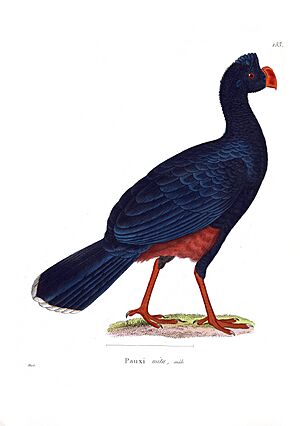Alagoas curassow facts for kids
Quick facts for kids Alagoas curassow |
|
|---|---|
 |
|
| Alagoas curassow | |
| Conservation status | |
| Scientific classification | |
| Genus: |
Mitu
|
| Species: |
mitu
|
 |
|
| Synonyms | |
|
|
The Alagoas curassow (Mitu mitu) is a beautiful bird that looks a bit like a pheasant. It has shiny black feathers. This bird used to live in the forests of northeastern Brazil. It was found in areas now known as the states of Pernambuco and Alagoas. That's how it got its common name!
Sadly, the Alagoas curassow is now extinct in the wild. This means you can only find these birds living in special places where people care for them. There are about 130 of them in captivity today.
A German scientist named Georg Marcgrave first wrote about the Alagoas curassow in 1648. For a long time, people weren't sure if this bird was a real, separate species. This was because there weren't many examples of it. But in 1951, an adult female curassow was found again. It was in the coastal forests of Alagoas. After this, the Mitu mitu was accepted as its own species.
At that time, fewer than 60 birds were left in the wild. They lived in the forests around São Miguel dos Campos. In the 1970s, many people worried about their disappearing home. The last large forests where these birds lived were cut down. This happened to make room for sugarcane farms.
Contents
What Does the Alagoas Curassow Look Like?
The Alagoas curassow is a fairly large bird. It measures about 83 to 89 centimeters (about 33 to 35 inches) long. Its body feathers are black and very shiny. They have a lovely blue-purple shimmer.
This bird also has a big, bright red beak. The beak is flat on its sides and has a white tip. Its legs and feet are also bright red. The tips of its tail feathers are light brown. Under its tail, the feathers are a chestnut color.
A special feature of this curassow is a grey, crescent-shaped patch of bare skin. This patch covers its ears. No other curassow has this unique mark. This helps scientists know it's a different species. Male and female birds look very similar. Females are usually a bit lighter in color and slightly smaller. These birds can live for more than 24 years when cared for by humans. They sometimes make a high-pitched chirping sound.
Where Did They Live?
The Alagoas curassow's natural home was in warm, wet lowland forests. These were primary forests, meaning they were old and untouched. In the wild, they ate fruits from plants like Phyllanthus and Eugenia. They also ate "mangabeira" fruits. Their native home was in the states of Alagoas and Pernambuco in Northeastern Brazil. Sadly, they no longer exist there.
How Many Are Left?
Since 1977, all Alagoas curassows have lived in captivity. In the year 2000, there were 44 of them. By 2008, the number grew to 130 birds. These birds live in two special bird parks. About 35% of these birds are mixed with another species. They are part Alagoas curassow and part razor-billed curassow.
Breeding Habits
We don't know much about their breeding habits in the wild. This is because they disappeared from nature before much study could be done. In captivity, female Alagoas curassows start having chicks around 2 years old. They usually lay about 2 to 3 eggs each year.
After 1990, scientists started breeding them with closely related razor-billed curassows. This helped to increase the variety in their genes. This is important for keeping the population healthy.
Conservation Efforts
Since this species is extinct in the wild, all 130 birds live in two separate captive groups. There are plans to reintroduce them back into nature. However, this is a big challenge. Even if the population grows to healthy numbers, they need a large natural area to live in.
Sadly, human growth has destroyed almost all of their natural home. One possible place for reintroduction has been suggested. People would need to take steps to protect them from illegal hunting if they return to the wild.
Why Did They Disappear?
The Alagoas curassow became extinct in the wild because of deforestation and hunting. Deforestation means cutting down forests. The last wild Alagoas curassow was seen and killed around 1984, or possibly 1987 or 1988.
The birds in captivity have been mixed with the razor-billed curassow. But there are still several dozen purebred birds left. These birds are cared for and bred in two private bird parks in Brazil.
What Do They Eat?
Alagoas curassows are known to eat fruits and nuts. Scientists found fruits from the castelo tree in their stomachs. They also seem to enjoy fruits from the plant Clarisia racemosa.
We don't know much about how they act with other species in the wild. For example, the Chamek spider monkey also eats Clarisia racemosa. This could mean they would compete for food if the curassows returned to the wild.
Scientists are working to control how the birds mate. They pair certain birds together. This helps to reduce mixing with other species. It also helps to keep the original Alagoas curassow genes strong.
Future of the Species
Scientists are studying the DNA of the "original" birds. This helps them decide which birds to pair for breeding. The goal is to keep the species alive and increase their genetic variety. Once there are enough birds in captivity, they can start to be released back into the wild. The best places would be large forest areas that are still left. Two such places are Usina Utinga-Leão and Usina Serra Grande.
Images for kids



